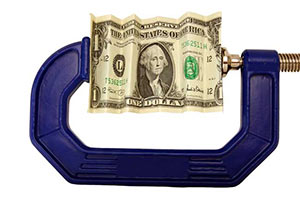Cash crunch: what’s the best type of loan for your business?
Posted on: July 18th, 2017
 Cash crunch is a common phenomenon in business, particularly as growth ramps up and cash is needed to expand production. Investment in people, inventory or capacity is frontloaded, yet resulting cash from the increase in sales is back loaded.
Cash crunch is a common phenomenon in business, particularly as growth ramps up and cash is needed to expand production. Investment in people, inventory or capacity is frontloaded, yet resulting cash from the increase in sales is back loaded.
This leads to a greater investment in net working capital, resulting in more cash being tied up in your working capital, tightening the available cash resources of the business. This creates what’s known as the growth paradox, in that it takes more capital, not less capital to support growth.
You can easily underestimate this and wind up with little excess cash, stretched payables and irritated vendors. Sometimes, when recovering from a bad year or two, companies push the losses into their working capital, often through permanently stretching their vendors to the limit.
When business picks up again, they no longer have room under their credit lines with vendors to meet the surge in new orders and can hit the wall from a liquidity standpoint. If the vendors pull the plug, you are toast and can end up completely illiquid on a COD basis with all vendors.
The best way to avoid this fate is to have your finger on the pulse of your working capital position. Appreciate the simple fact that it is easier to go bust when you are growing then when you are contracting.
Having more cash on hand is a smart way to prevent falling into this trap. Here are three loan structures that will bridge this transitional capital need and put you on solid working capital footing:
- Line of Credit Over advance – this structure gives a company more credit against its working capital and allows a company to go out of line of credit formula. This provides much needed extra capital during transitional period.
- Mezzanine loan – structured against a multiple of EBITDA, these loans are long term, flexible and perfect for transitional or long term expansion. Akin to equity, they give a company space and time to expand in scale to meet greater demand.
- USDA loan – structured against the liquidation value of hard assets or equipment, these loans are great for expansion projects for manufacturing companies. The terms can expand up to 20 years, with low single digit interest rates due to the government guarantee.
- Senior term loan – these loans are structured against both assets and cash flow. They give a company breathing room by term out a portion of their line of credit, giving more headroom to fund future asset growth.
